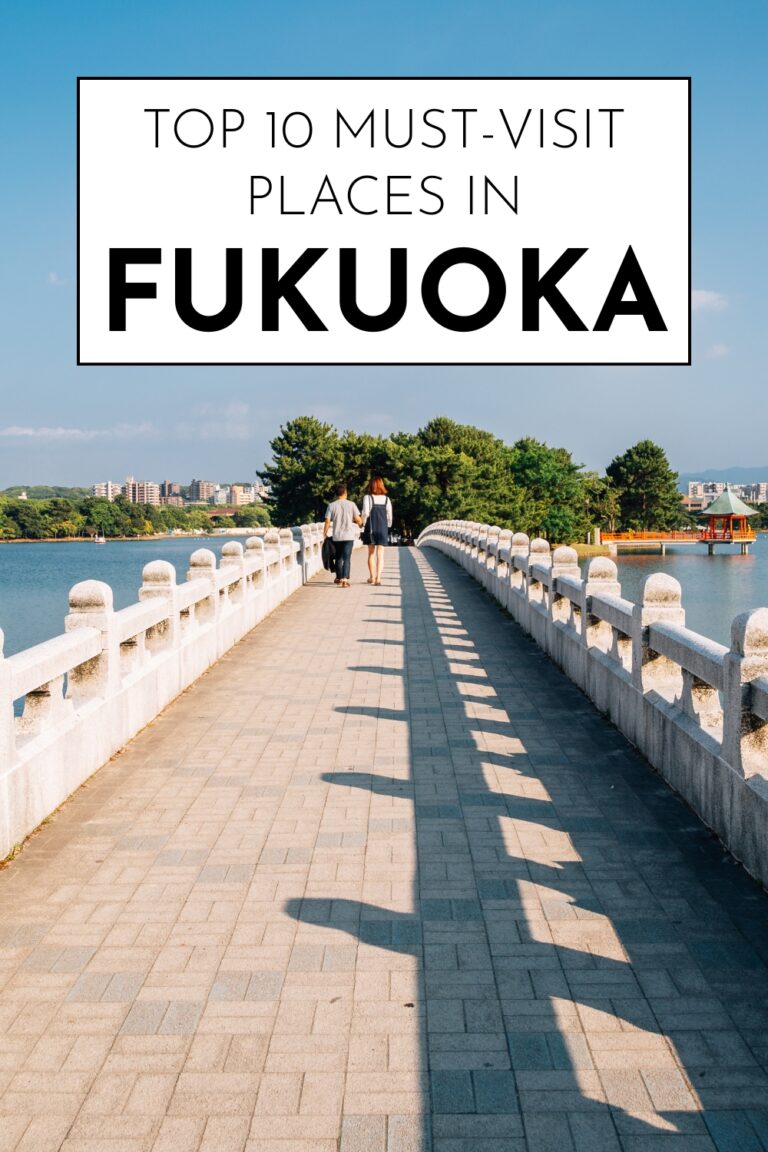Fukuoka, Japan’s gateway to Asia, stands as one of the country’s most dynamic and welcoming cities. Located on the northern shore of Kyushu Island, this vibrant metropolis perfectly balances ancient Japanese traditions with modern urban energy, creating an unforgettable destination for travelers seeking authentic cultural experiences.
Known for its incredible food scene, historic temples, beautiful parks, and warm hospitality, Fukuoka offers visitors a more relaxed and affordable alternative to Tokyo or Osaka. The city’s compact size makes it easy to explore, while its rich history spanning over 2,000 years provides countless opportunities for cultural discovery.
From legendary ramen shops that have perfected their craft over generations to peaceful shrine complexes where cherry blossoms bloom in spring, Fukuoka delivers experiences that capture the essence of Japanese culture. The city’s strategic location has made it a cultural crossroads, blending influences from mainland Asia with distinctly Japanese traditions.
Let’s explore the ten essential destinations that make Fukuoka a must-visit city for anyone traveling to Japan.
1. Dazaifu Tenmangu Shrine – Sacred Learning Temple

Dazaifu Tenmangu stands as one of Japan’s most important shrines, dedicated to Sugawara no Michizane, the deity of learning and academic success. Located just 30 minutes from central Fukuoka, this magnificent shrine complex attracts millions of visitors annually, especially students praying for success in their studies.
Historical Significance and Spiritual Importance
Built in 919 AD, the shrine honors Sugawara no Michizane, a scholar and politician who was exiled to Dazaifu in the 9th century. After his death, he was deified as Tenjin, the god of learning, literature, and academic achievement. The shrine’s main hall showcases stunning traditional Japanese architecture with its distinctive curved rooflines and intricate wooden details.
The approach to the shrine features over 6,000 plum trees that bloom spectacularly from late January to early March, creating one of Japan’s most beautiful early spring displays. These plum blossoms hold special significance as they were Michizane’s favorite flowers.
Cultural Activities and Experiences
Visitors can participate in traditional Japanese customs like writing wishes on wooden ema plaques or purchasing omamori (protective charms) for academic success. The shrine grounds include several smaller buildings, traditional gardens, and a treasure hall displaying historical artifacts.
The nearby Dazaifu town offers traditional sweets, local crafts, and restaurants serving regional specialties. The famous Kasanoko treats, shaped like plum blossoms, make perfect souvenirs from this sacred site.
Best time to visit: February-March for plum blossoms, year-round for cultural significance
Key highlights: Main shrine hall, plum grove, traditional ceremonies
Transportation: 30 minutes from Fukuoka city center
Cultural significance: God of learning and academic success
2. Canal City Hakata – Modern Shopping Paradise
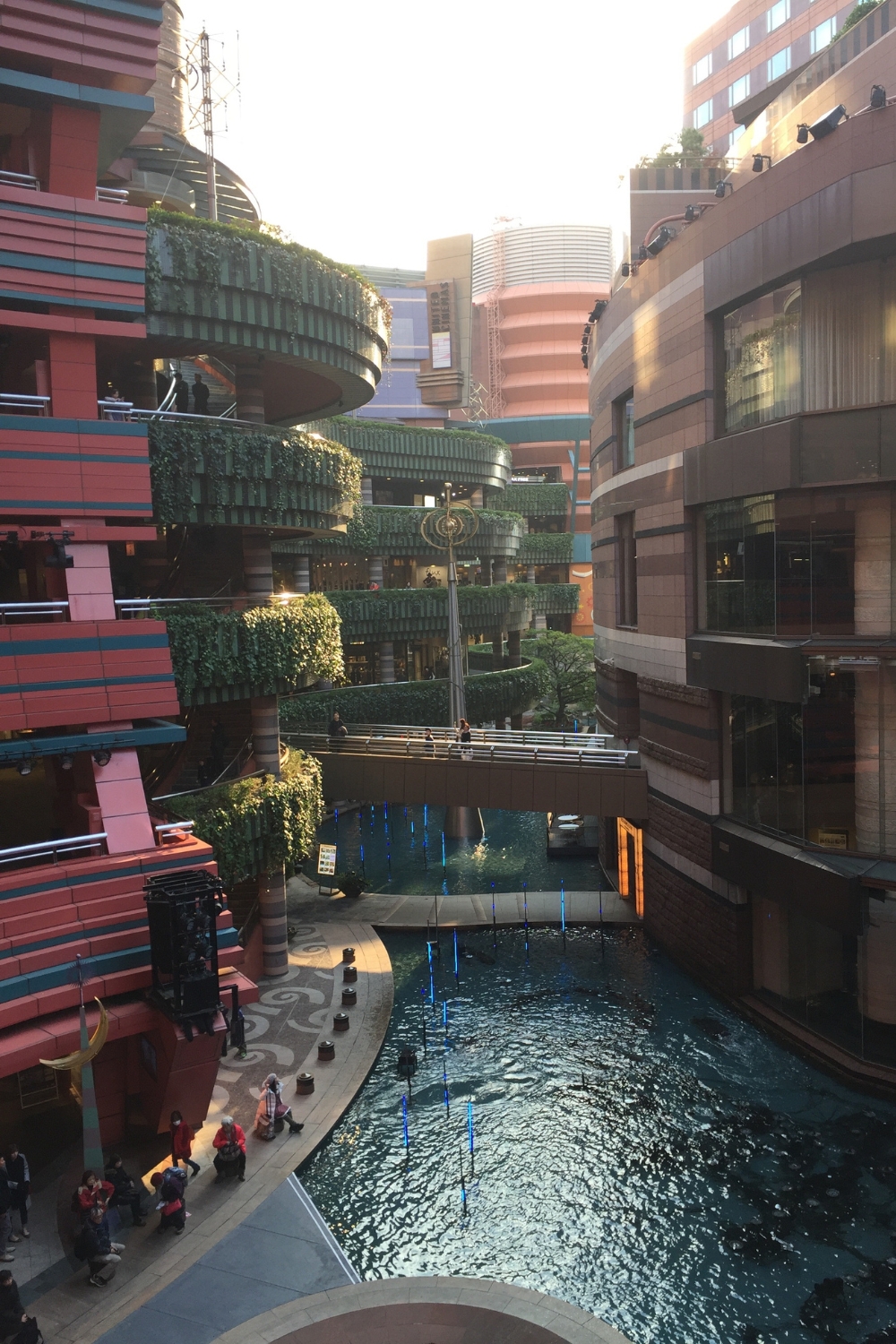
Canal City Hakata represents Fukuoka’s modern face as a spectacular shopping and entertainment complex that resembles a futuristic city within the city. This architectural marvel features a canal running through its center, creating a unique shopping experience that combines retail therapy with visual spectacle.
Unique Architecture and Design
Designed by American architect Jon Jerde, Canal City’s curved buildings and flowing water create an atmosphere unlike any other shopping center in Japan. The complex houses over 250 shops, restaurants, a hotel, movie theaters, and entertainment venues across multiple levels connected by bridges and walkways.
The centerpiece canal features regular fountain shows with music and lights, creating a festive atmosphere throughout the day. The complex’s design encourages exploration, with each level offering different shopping and dining experiences.
Shopping and Entertainment Hub
Canal City caters to all tastes and budgets, from high-end international brands to unique Japanese retailers. The complex includes a 13-screen movie theater, live performance spaces, and numerous restaurants serving both Japanese and international cuisine.
The Ramen Stadium on the fifth floor offers multiple ramen shops representing different regional styles, making it perfect for food enthusiasts wanting to sample various Japanese noodle traditions. Regular events, exhibitions, and seasonal decorations keep the complex dynamic and exciting.
Operating hours: 10:00 AM – 9:00 PM (restaurants until 11:00 PM)
Key features: Canal with fountain shows, 250+ shops, Ramen Stadium
Best for: Shopping, dining, entertainment, rainy day activities
Location: Central Hakata, easy access from major hotels
3. Fukuoka Castle Ruins and Maizuru Park – Historical Heart
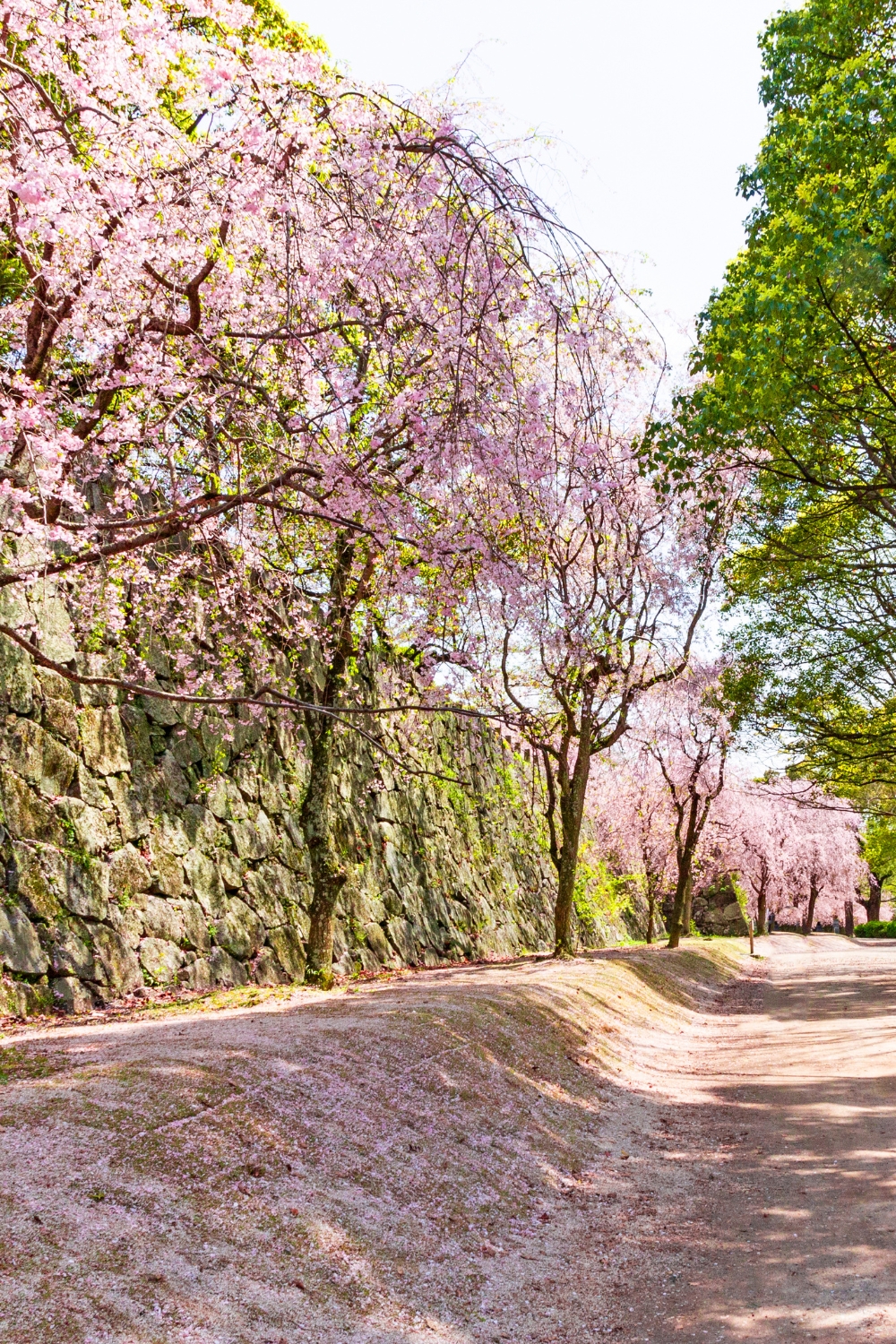
The ruins of Fukuoka Castle, set within beautiful Maizuru Park, offer visitors a glimpse into the city’s feudal past while providing one of Japan’s most celebrated cherry blossom viewing spots. Built in the early 1600s, the castle once served as the seat of power for the Kuroda clan who ruled the region.
Historical Legacy and Castle Remains
Although the main castle buildings no longer stand, the impressive stone foundations, walls, and several gates remain to tell the story of this once-mighty fortress. The castle’s strategic location on a hill overlooking Hakata Bay made it a crucial defensive position during Japan’s feudal period.
Archaeological work continues to uncover new aspects of the castle’s history, and recent reconstructions of some buildings help visitors understand the scale and importance of the original complex. Information boards throughout the site provide historical context in both Japanese and English.
Cherry Blossom Paradise and Seasonal Beauty
Maizuru Park surrounding the castle ruins contains over 1,000 cherry trees that create spectacular displays during spring blooming season. The park becomes one of Fukuoka’s most popular hanami (cherry blossom viewing) spots, with families and friends gathering for picnics beneath the pink canopy.
Beyond cherry blossoms, the park offers year-round beauty with seasonal flowers, peaceful walking paths, and panoramic views over the city and bay. The park’s traditional Japanese garden features carefully maintained landscapes that showcase the changing seasons.
Best time to visit: Late March to early April for cherry blossoms
Key features: Castle ruins, stone walls, cherry trees, city views
Activities: Historical exploration, hanami parties, photography
Entry fee: Free for park, small fee for some castle areas
4. Ohori Park – Urban Oasis and Traditional Gardens
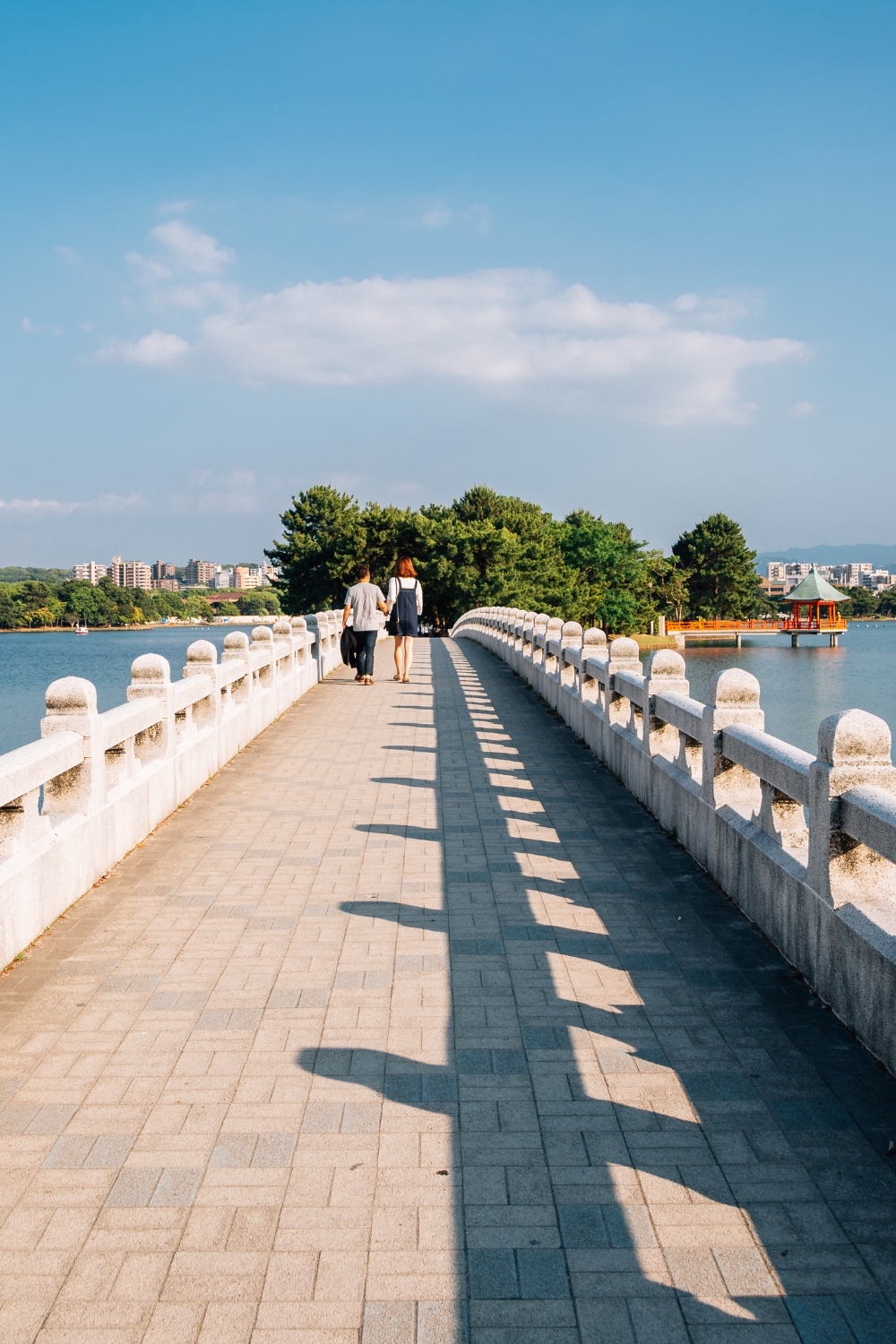
Ohori Park creates a peaceful retreat in the heart of Fukuoka, centered around a large pond that was once part of the outer moat of Fukuoka Castle. This beautifully designed park combines traditional Japanese garden aesthetics with Western-style landscaping, creating a perfect urban escape.
Traditional Japanese Garden Excellence
The park’s centerpiece is a classical Japanese garden featuring meticulously maintained landscapes, traditional bridges, tea houses, and seasonal plantings. The garden represents different Japanese landscape styles, from dry rock gardens to carefully pruned pine trees that create living sculptures.
The large central pond supports various bird species and provides a habitat for koi fish, turtles, and other aquatic life. Three islands connected by elegant bridges offer different perspectives of the park and create perfect spots for contemplation and photography.
Recreation and Cultural Activities
Ohori Park serves as Fukuoka’s premier location for outdoor activities, with a 2-kilometer jogging path around the pond that attracts local runners and fitness enthusiasts. Boat rentals allow visitors to explore the pond from water level, while the park’s open spaces host various festivals and events throughout the year.
The park houses the Fukuoka Art Museum, which showcases both contemporary and traditional Japanese art. The museum’s collection includes works by famous Japanese artists alongside international pieces, making it a cultural complement to the park’s natural beauty.
Park hours: Always open (gardens 9:00 AM – 5:00 PM)
Key features: Large pond, Japanese garden, jogging path, art museum
Activities: Walking, jogging, boating, museum visits, photography
Best for: Relaxation, exercise, cultural experiences, family outings
5. Nakasu District – Nightlife and Entertainment Quarter
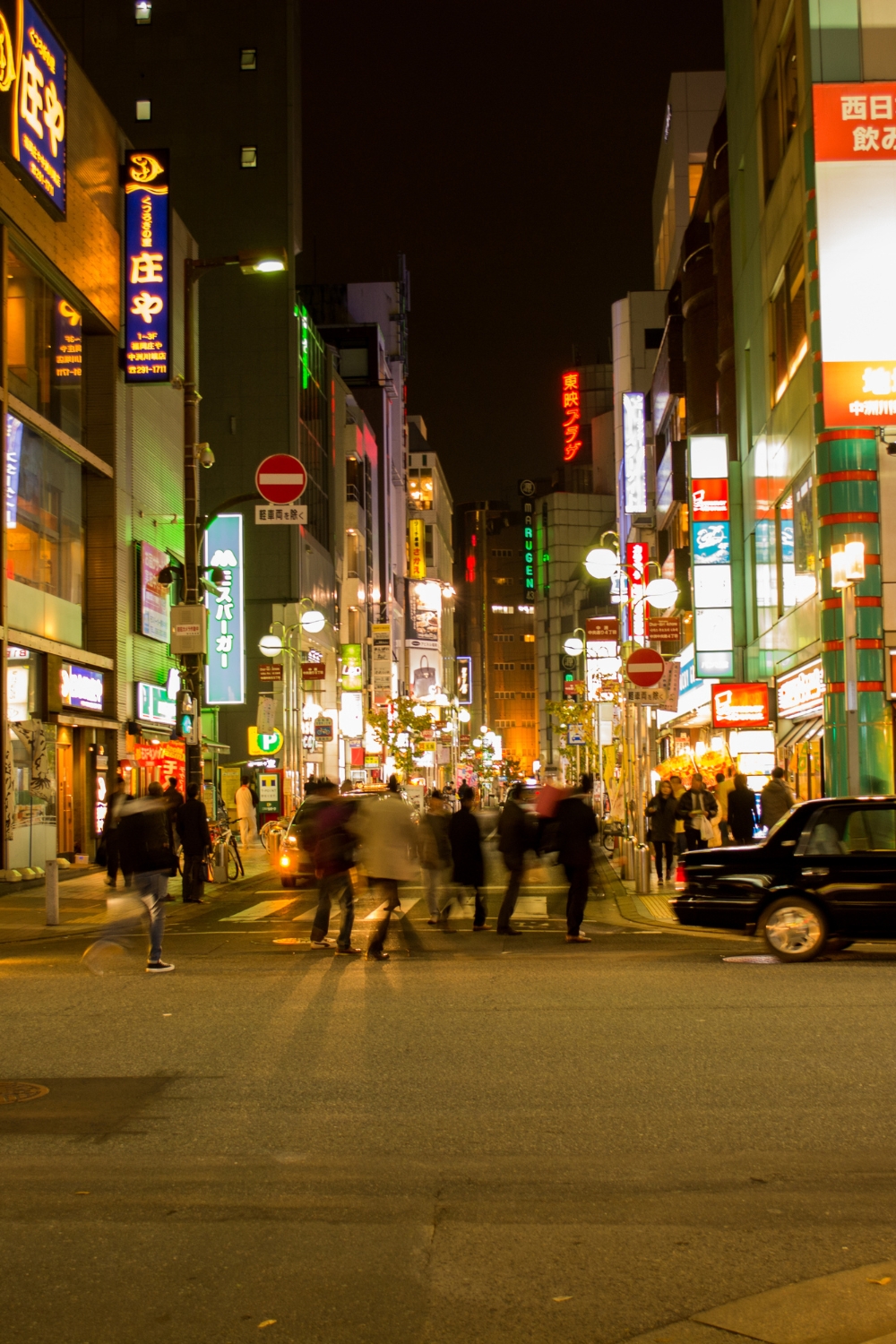
Nakasu, Fukuoka’s famous entertainment district, transforms into a neon-lit wonderland after dark. This small island between two rivers hosts over 3,000 bars, restaurants, and entertainment venues, making it one of Japan’s most concentrated nightlife areas.
Yatai Food Stalls and Street Food Culture
Nakasu’s most famous attraction is its collection of yatai (street food stalls) that line the riverbank each evening. These small, mobile restaurants serve authentic Fukuoka specialties like tonkotsu ramen, yakitori, and fresh seafood in an intimate, traditional setting.
Each yatai seats only 6-10 people, creating opportunities for conversation with locals and fellow travelers. The yatai culture represents an important part of Fukuoka’s social fabric, where businesspeople, students, and tourists mingle over delicious food and drinks.
Bars and Entertainment Venues
Beyond the yatai, Nakasu offers everything from cozy sake bars to modern cocktail lounges, karaoke boxes, and live music venues. The district caters to all tastes and budgets, from budget-friendly izakaya (Japanese pubs) to upscale establishments.
The area’s compact size makes bar hopping easy and safe, with most venues within walking distance of each other. English-speaking staff are common in tourist-friendly establishments, though learning a few Japanese phrases enhances the experience.
Operating hours: Evening until late night (yatai from 6:00 PM)
Key experiences: Yatai food stalls, sake bars, karaoke, live music
Best for: Nightlife, authentic food culture, socializing
Safety: Very safe, well-lit, regular police presence
6. Momochihama Beach Tower and Seaside Area – Coastal Relaxation
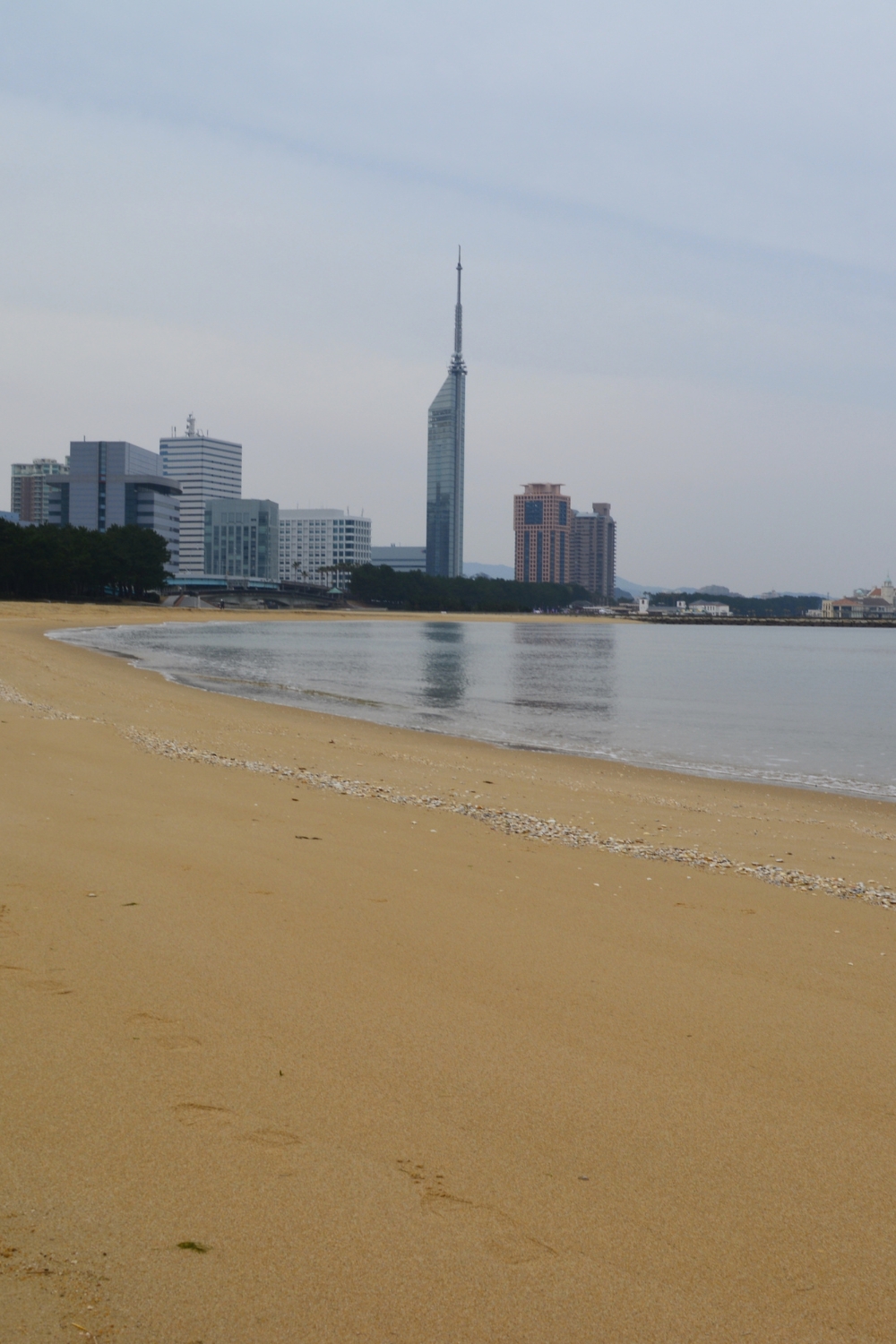
Momochihama represents Fukuoka’s modern coastal development, featuring a beautiful beach, the iconic Fukuoka Tower, and contemporary shopping and dining facilities. This area showcases the city’s successful urban planning and provides a perfect contrast to the historic districts.
Fukuoka Tower and Panoramic Views
Standing 234 meters tall, Fukuoka Tower offers spectacular panoramic views of the city, mountains, and Hakata Bay. The tower’s unique triangular design and mirrored exterior make it a striking landmark visible from throughout the city.
The observation deck provides 360-degree views that are particularly stunning during sunset and evening hours when the city lights create a magical atmosphere. Special lighting displays during holidays and seasons make the tower itself a beautiful sight from ground level.
Beach Activities and Coastal Recreation
Momochihama Beach offers a rare opportunity to enjoy seaside activities within a major Japanese city. The artificial beach features clean sand, designated swimming areas, and facilities for beach volleyball and other sports.
The beachside area includes parks, walking paths, and outdoor event spaces that host festivals and concerts throughout the year. The PayPay Dome (baseball stadium) nearby adds to the area’s entertainment options, especially during baseball season.
Tower hours: 9:30 AM – 10:00 PM (varies seasonally)
Key features: Observation deck, beach, shopping, dining, sports venues
Activities: Sightseeing, beach activities, shopping, sports events
Best time: Sunset for tower views, summer for beach activities
7. Kushida Shrine – Festival Central and Spiritual Center
Kushida Shrine serves as the spiritual heart of Fukuoka’s Hakata district and the starting point for the city’s most famous festival, Hakata Gion Yamakasa. This ancient shrine, founded in 757 AD, continues to play a central role in local religious and cultural life.
Ancient History and Religious Significance
The shrine dedicated to Amaterasu Omikami (the sun goddess) and other Shinto deities has witnessed over 1,200 years of continuous worship. The current buildings showcase traditional Japanese shrine architecture with their distinctive red and white color scheme and elegant curved rooflines.
The shrine’s holy spring, known as Reisen, is believed to have healing properties and has been flowing continuously for centuries. Visitors can drink from this sacred water and participate in traditional purification rituals before entering the main shrine grounds.
Hakata Gion Yamakasa Festival Heritage
Kushida Shrine is most famous as the home of the Hakata Gion Yamakasa, one of Japan’s most exciting festivals held every July. The festival features elaborate floats (yamakasa) and racing teams of men carrying portable shrines through the streets in a dramatic competition.
Even outside festival season, visitors can see display yamakasa in the shrine grounds, giving a sense of the festival’s scale and artistry. The shrine museum houses historical artifacts, festival costumes, and exhibits explaining the event’s 700-year history.
Visiting hours: 4:00 AM – 10:00 PM
Key features: Ancient shrine buildings, sacred spring, yamakasa displays
Festival season: July (Hakata Gion Yamakasa)
Cultural significance: Center of local spiritual and festival life
8. Tenjin Shopping District – Urban Commercial Hub
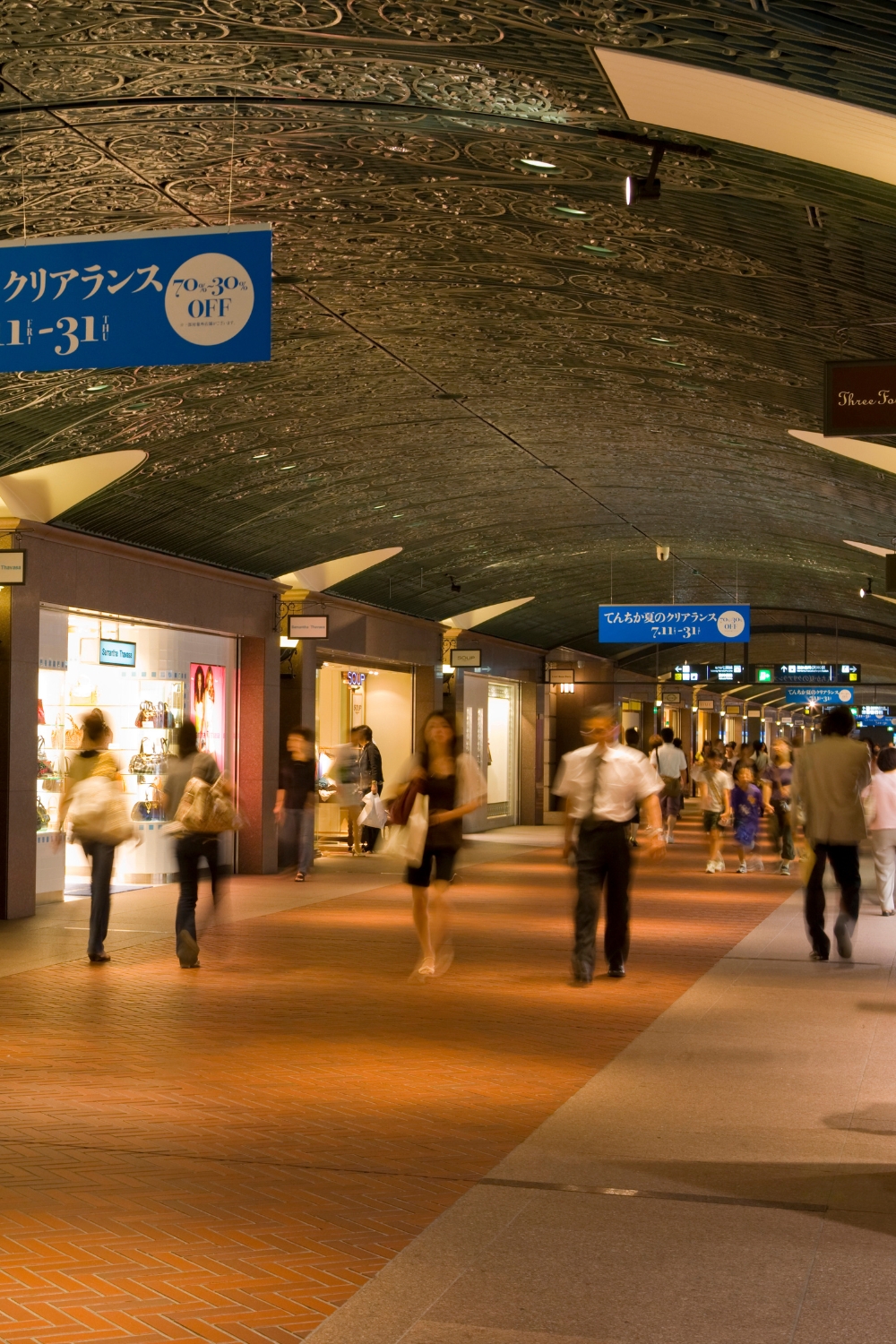
Tenjin stands as Fukuoka’s primary shopping and business district, offering everything from luxury department stores to quirky boutiques, traditional crafts to cutting-edge technology. This bustling area represents the commercial heart of the city and provides excellent opportunities for retail therapy and cultural observation.
Department Stores and Fashion Shopping
Tenjin houses major Japanese department stores like Daimaru, Mitsukoshi, and Iwataya, each offering multiple floors of fashion, cosmetics, food, and household goods. These stores provide excellent opportunities to experience Japanese retail culture and customer service standards.
The underground shopping areas connect multiple buildings and subway stations, creating a weather-proof shopping network that’s particularly appreciated during hot summers or rainy seasons. These underground passages often house smaller shops, restaurants, and services.
Local Culture and Street Life
Beyond shopping, Tenjin offers excellent people-watching opportunities as locals go about their daily business. The area’s coffee shops, restaurants, and public spaces provide insights into modern Japanese urban life and social customs.
Street performers, seasonal decorations, and promotional events add energy to the district throughout the year. The area’s mix of traditional and modern elements creates a uniquely Japanese shopping experience that differs significantly from Western commercial districts.
Operating hours: Varies by store (typically 10:00 AM – 8:00 PM)
Key features: Department stores, underground shopping, restaurants
Best for: Shopping, dining, cultural observation, bad weather activities
Transportation: Central subway connections to all city areas
9. Shofukuji Temple – Zen Buddhism Heritage
Shofukuji Temple holds the distinction of being Japan’s first Zen temple, founded in 1195 by the monk Eisai who introduced Zen Buddhism to Japan from China. This historically significant temple complex offers visitors insight into Japanese Buddhist traditions and architectural beauty.
Historical Importance and Zen Buddhism
The temple’s founding marked a pivotal moment in Japanese religious history, as Zen Buddhism would go on to profoundly influence Japanese culture, arts, and philosophy. The temple buildings showcase classic Zen architectural principles with their clean lines, natural materials, and harmonious proportions.
The temple grounds include multiple buildings, each serving different functions within the monastic community. The main hall, gates, and meditation spaces demonstrate the aesthetic principles that Zen Buddhism brought to Japanese architecture and design.
Meditation and Spiritual Experiences
Shofukuji continues to function as an active Zen temple where monks practice meditation and maintain traditional Buddhist customs. Visitors can observe these practices respectfully and sometimes participate in meditation sessions or temple ceremonies.
The temple gardens exemplify Zen principles with their carefully composed landscapes that encourage contemplation and inner peace. The seasonal changes in the gardens provide different meditative experiences throughout the year.
Visiting hours: 9:00 AM – 5:00 PM
Key features: Historic Zen architecture, meditation gardens, active temple life
Cultural significance: First Zen temple in Japan
Activities: Meditation, architectural appreciation, spiritual reflection
10. Fukuoka Food Scene – Culinary Cultural Immersion
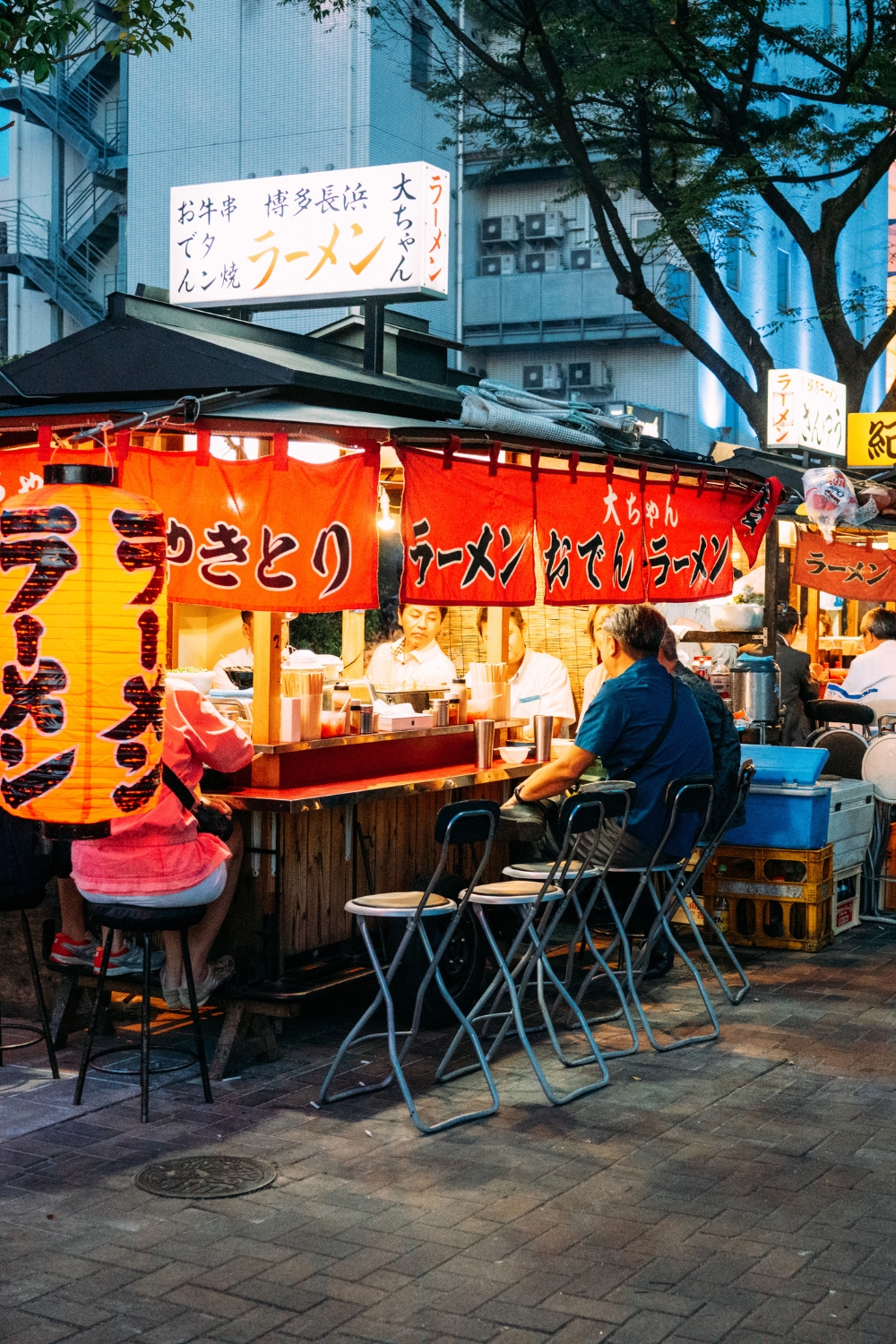
Fukuoka’s food scene represents one of Japan’s great culinary treasures, with the city famous for its ramen, fresh seafood, and unique local specialties. The city’s location makes it a crossroads of culinary influences, creating distinctive flavors that can’t be found elsewhere in Japan.
Ramen Culture and Tonkotsu Tradition
Fukuoka is the birthplace of tonkotsu ramen, featuring rich, creamy broth made from pork bones simmered for hours. The city’s ramen shops range from tiny family-run establishments to famous chains, each with their own secret recipes and loyal followings.
Ichiran, Ippudo, and other internationally known ramen brands started in Fukuoka, but the city’s best ramen often comes from small, local shops that have perfected their craft over generations. The yatai street stalls provide the most authentic ramen experience, combining excellent food with traditional atmosphere.
Fresh Seafood and Local Specialties
Fukuoka’s coastal location provides access to incredibly fresh seafood, with local specialties including mentaiko (spicy cod roe), fresh uni (sea urchin), and seasonal fish preparations. The city’s fish markets and sushi restaurants showcase the best of Kyushu’s marine bounty.
Other local specialties include mizutaki (chicken hot pot), yakitori, and various regional sweets and snacks. Fukuoka’s food culture encourages exploration and experimentation, with many dishes specifically designed for sharing and socializing.
Must-try dishes: Tonkotsu ramen, mentaiko, mizutaki, fresh seafood
Best areas: Nakasu (yatai), Tenjin (restaurants), local neighborhoods
Food experiences: Ramen tours, cooking classes, market visits
Dining culture: Casual, social, emphasis on fresh ingredients
Planning Your Fukuoka Adventure
Getting Around the City
Fukuoka’s efficient public transportation system makes exploring the city easy and affordable. The subway system connects all major districts, while buses provide access to suburban areas and specific attractions. Many attractions are within walking distance of each other, particularly in the central Hakata and Tenjin areas.
For day trips to places like Dazaifu Tenmangu, private train lines offer convenient connections. Renting a bicycle provides a pleasant way to explore the city’s flatter areas and parks.
Best Time to Visit Different Attractions
Spring (March-May): Perfect for cherry blossoms at Maizuru Park and Ohori Park, comfortable temperatures for walking and outdoor activities.
Summer (June-August): Great for beach activities at Momochihama, though hot and humid. Indoor attractions like Canal City and museums provide air-conditioned relief.
Autumn (September-November): Ideal weather for all activities, beautiful fall colors in parks and temple grounds.
Winter (December-February): Mild temperatures, fewer crowds, plum blossoms at Dazaifu Tenmangu from late January.
Cultural Etiquette and Local Customs
Respect Japanese customs when visiting temples and shrines: bow before entering, don’t touch sacred objects, and follow photography guidelines. Remove shoes when entering traditional buildings and keep voices low in sacred spaces.
Fukuoka’s food culture encourages slurping noodles and expressing appreciation for meals. Tipping is not customary in Japan, and many places don’t accept credit cards, so carry cash.
Conclusion
Fukuoka offers an incredible blend of cultural depth, culinary excellence, and modern convenience that makes it an ideal destination for experiencing authentic Japanese culture. From the sacred plum groves of Dazaifu Tenmangu to the neon-lit yatai stalls of Nakasu, from peaceful temple gardens to bustling shopping districts, the city provides diverse experiences that satisfy every type of traveler.
These ten must-visit places represent the essence of what makes Fukuoka special: its ability to preserve traditional Japanese culture while embracing modern life, its world-class food scene that rivals any city in Japan, and its welcoming atmosphere that makes visitors feel at home.
Whether you’re interested in history and spirituality, food and nightlife, shopping and entertainment, or simply experiencing daily life in a dynamic Japanese city, Fukuoka delivers memorable experiences that will leave you planning your return visit.
The city’s compact size and excellent transportation make it possible to experience multiple attractions in a single day, while its reasonable costs and friendly locals create an accessible introduction to Japanese culture. Start planning your Fukuoka adventure today and discover why this dynamic city has become one of Japan’s most beloved destinations for travelers seeking authentic experiences.
